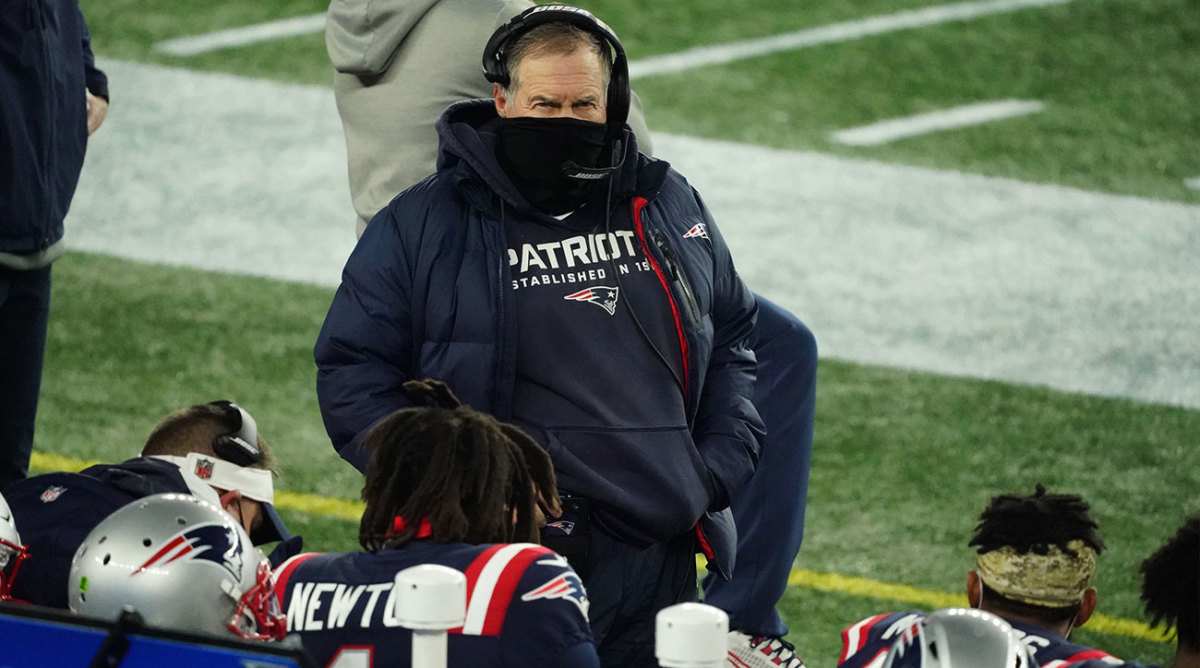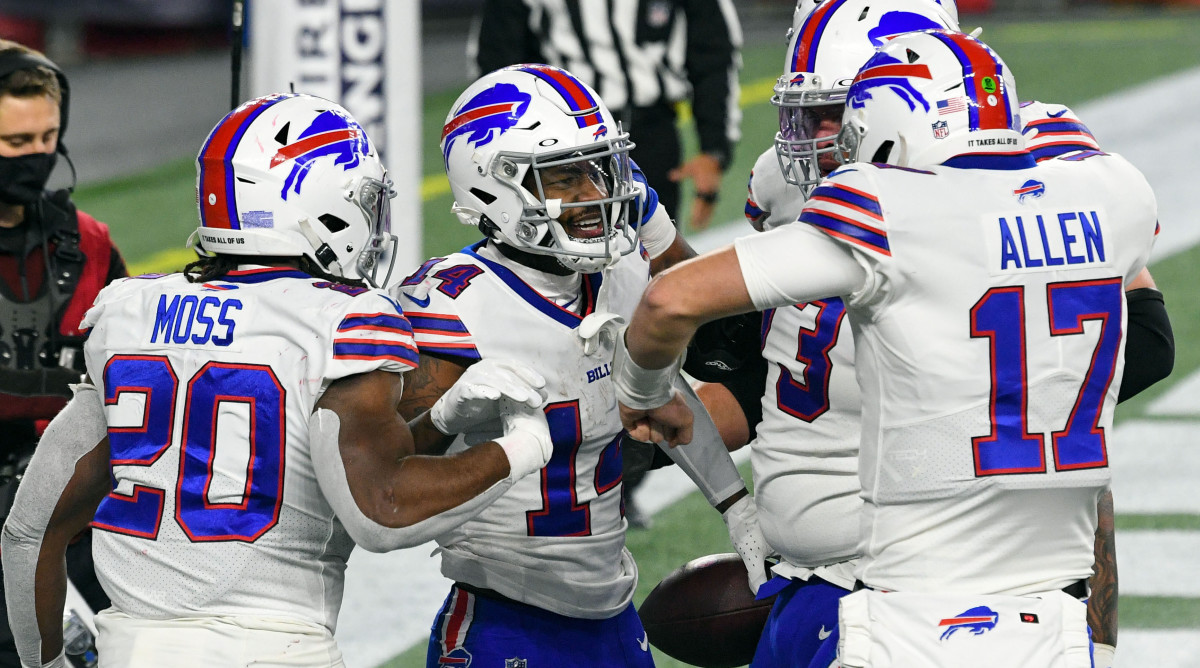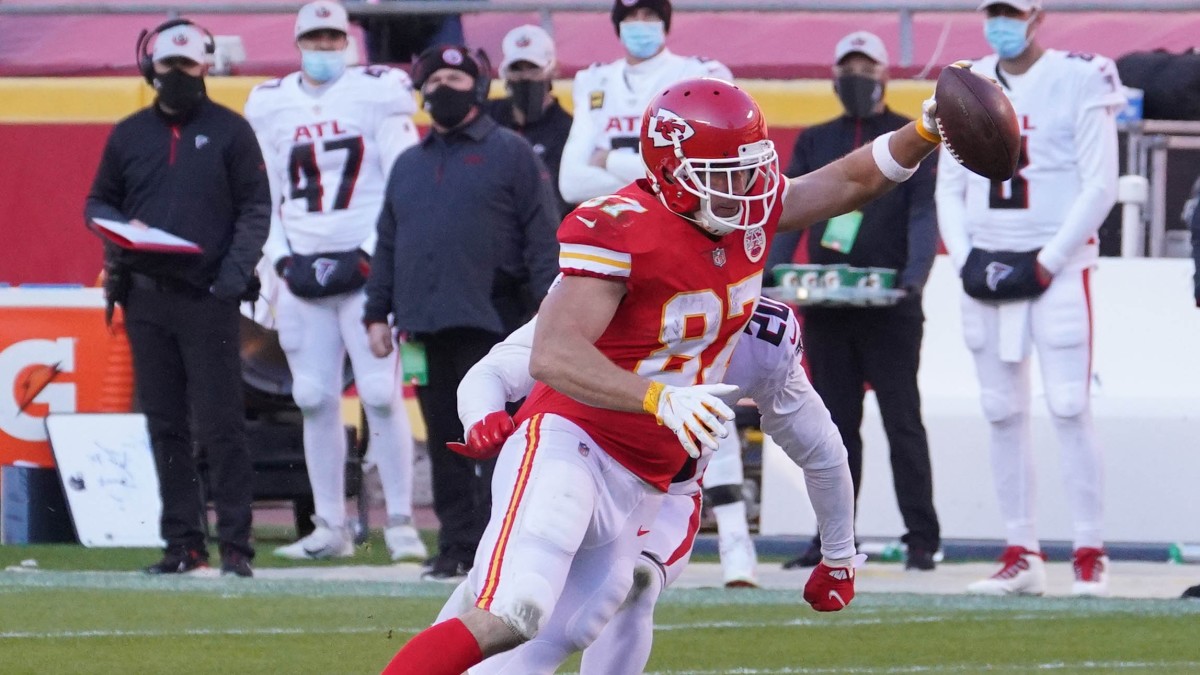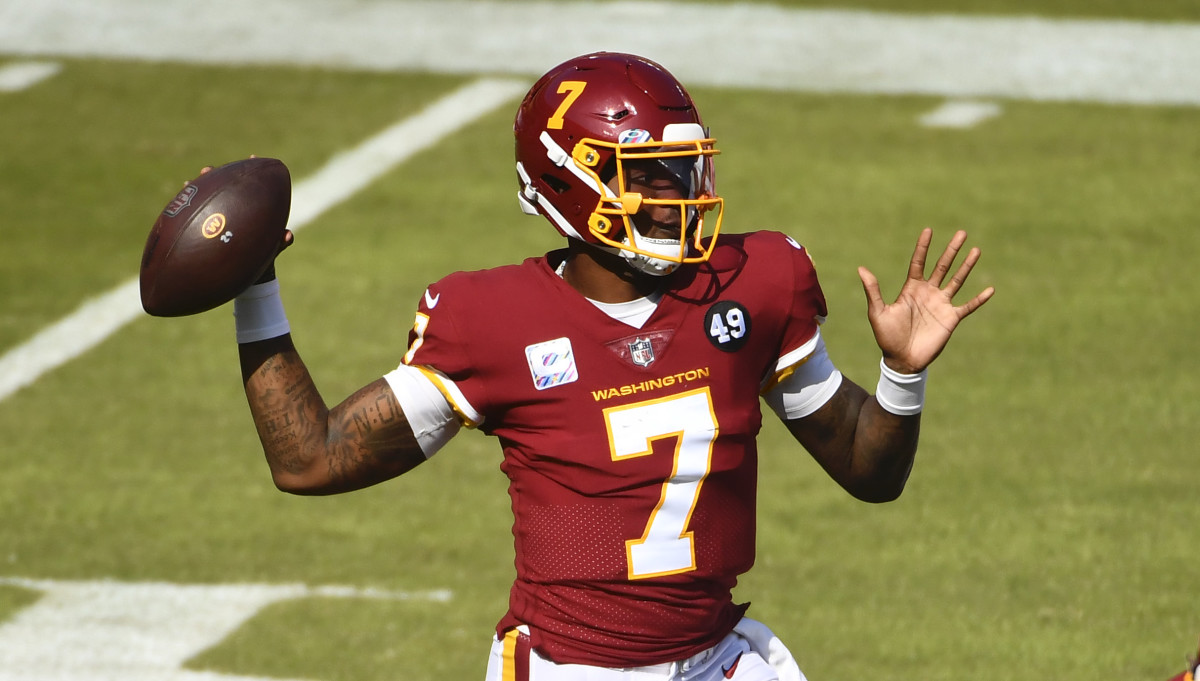How the Wheels Came Off the Patriots' Dynasty
It was fourth-and-one, and into the final minute of the first quarter of Buffalo’s could’ve-been-worse 38–9 beatdown of the Patriots, and a chaotic situation was unfolding.
As Josh Allen got his teammates to the line, Bill Belichick’s staff was swapping out one group for another. Josh Uche, Terrence Brooks, Jonathan Jones, Myles Bryant and Chase Winovich rushed off the field, and on came John Simon, Byron Cowart, Terez Hall and Akeem Spence.
On one hand, this frantic personnel dance was perfectly Patriots—with Belichick gaming a situation with a certain group of players coming in to combat it. On another, the result was anything but. Defensive tackle Adam Butler jumped offside, Allen gashed New England for 22 yards on a boot, prompting the Bills to decline the resulting penalty and, worst of all, if you count the names above, you’ll see the Patriots only had 10 guys out there for all this.
But there’s something else there, too, a little deeper under the surface.

That New England had to switch out so many guys, something they’ve done for chunks of this year, is telling. On Monday, based on snap percentages, they really had four full-time guys: safety Adrian Phillips and corners J.C. Jackson, Jason McCourty and Jones. If you go back a week, to the Miami game, that number was three, with Jackson being the only one overlapping (Hall and Jones were the other two full-timers against the Dolphins).
Bottom line: There was a time when Belichick’s tinkering with his lineup like this was a sign of his brilliance as a football coach, and this very clearly isn’t that. To those who’ve faced the Patriots, this more than anything is a sign of a team lacking top-end talent.
“They’re just devoid of talent,” said an NFC personnel director who’s studied the Patriots. “It’s a bunch of specialty guys that fit certain scenarios, and those guys are fine, but they don’t have line-up-and-kick-your-ass football players. [Stephon] Gilmore’s a real guy. [Joe] Thuney’s a real guy. I like J.C. Jackson. But other than that, I don’t know who we’re really talking about.
“I know this: Vince Wilfork, Ty Warren, Richard Seymour, Mike Vrabel, Willie McGinest, Asante Samuel—they weren’t taking those guys off the field situationally. Those guys lined up and kicked the other guy’s ass.”
Without that? Without that, it’s other guys doing the whooping. And predictably on Monday, for the third straight week, it was the Patriots taking the whooping.
Now, the question becomes how many more shiners New England’s going to have to wear before Belichick can get the team back where he wants it.
***
We’ve reached the end of the regular season, and there’s a lot to get to ahead of Week 17. In this week’s Gameplan …
• Dwayne Haskins's future.
• How the coaching carousel will impact the QB market.
• Power rankings!
But we’re starting with the wheels coming off the greatest dynasty in modern NFL history, and where everything went so wrong.
***
This Sunday, the Patriots will play the least relevant game in the 19-year history of Gillette Stadium, hosting the 2–13 Jets. New England’s got draft position on the line, and the Jets, locked into the second overall pick, don’t even have that. And the Patriots opened as a 4.5-point favorite, which, if you shave off the obligatory three points given to the home team, means Vegas sees these two groups as damn near even.
On the surface, given history, that seems absurd.
But a look at where the Patriots are from a roster standpoint shows it to be less so.
When the game’s over, the real work in New England will begin—and there is a lot of work, and maybe even some self-reflection, to be done. Because if you look at how the Patriots got here, it’s pretty clear this result has been a long time coming. (We actually looked at the looming issue two years ago, with the Patriots on their way to a sixth Super Bowl title.)
The quarterback. This is an easy one, on the surface. Cam Newton walked into a bad situation that no quarterback would’ve been able to fix (Brady’s passer rating during last year’s 4–5 finish: 80.3), and his play only made it worse, and that’s an obvious starting point for this discussion.
But the truth is the Patriots lost more than a quarterback in Brady. They lost the ultimate fixer. Brady didn’t create margin for error. He was the margin for error. Got a little less at receiver? Tom will get you in the right looks and throw guys open. Got issues on the line? He’ll give you an edge in setting protections and get rid of the ball faster. Got less on defense? He’s cool to play in shootouts. And so on.
“To me, Brady masked their misses over the years,” said an AFC exec. “Just look at their draft history. You see picks missed on, but Brady, [Rob Gronkowski], [Julian] Edelman, they’d mask those issues. … [Belichick’s] still one of the best coaches—he’s such a good coach, and Josh [McDaniels] is such a good coordinator, and they have overcome lack of talent in the past. But now they don’t have the quarterback, and it’s tough to mask everything else.
“I mean, look at the skill positions. They don’t have anybody you’re scared of.”
“Is their roster ever spectacular?” asked an NFC personnel director. “I’m not sure it ever was, but they had an unbelievable coach and an unbelievable quarterback. … What [Brady] did to bring everyone up around him was incredible. The beauty of what they’ve done, they trade back, they get picks, they bring in bodies, and guys that fit them. Then they lose that guy who’s been making it all work, it’s tough.”
The issues in scouting. The Patriots have bled promising young scouts over the last few years in part because those guys wanted to have a real voice in the process—something very few felt like they had in Foxboro. And drafting N’Keal Harry in the first round is a strong example of it.
Harry perfectly illustrates Belichick’s scouting blind spot. Belichick’s close with Harry’s college coach, ex-Arizona State coach Todd Graham, and Harry crushed his in-house visit with the team in the spring of 2019, doing a better job with his turn in Foxboro than Deebo Samuel or A.J. Brown did with theirs. So despite warning signs from the scouts on Harry, the team wound up taking Harry in the first round.
You know the rest. Brown and Samuel look like future Pro Bowlers. Harry has 397 yards over two years and doesn’t seem like a lock to make the team next year. And he’s just one example. Another is 2020 third-rounder Anfernee Jennings, a limited linebacker who Nick Saban called his “favorite player” to some teams. He, predictably, was overdrafted by Belichick. There are more, too.
This one isn’t that tough to diagnose, of course, and comes not just down to what Belichick values in players, but also in where he’s getting his information. Which makes it fair to question if he’s leaned too much on his college coaching friends and his personal experience with prospects, and too little on the work of his scouts.
The core positions. Simply put, the Patriots are bad at positions they’re normally good at. Quarterback’s the most obvious example. But linebacker and tight end are two more.
The best Patriots teams were highly-invested in those spots, and it makes sense that they were—they’re positions that demand the most versatility, which allows a coach like Belichick to be multiple, and they’re undervalued financially against what, say, top-shelf receivers or corners get, allowing for a team to better manage its resources. Foxboro used to overflow with examples of this. Vrabel, McGinest, Tedy Bruschi, Ted Johnson, Jamie Collins, Jerod Mayo, Dont’a Hightower, Kyle Van Noy, Ben Watson, Daniel Graham, Christian Fauria, Gronkowski, Aaron Hernandez and Martellus Bennett were all among them.
Now, they’ve got Ju’Wuan Bentley, Hall, Devin Asiasi, Dalton Keene and a bunch of other guys you’ve never heard of.
“The first thing that jumps out is how different the tight end position is,” said an AFC personnel director. “It’s so obvious, but to go from not just Gronk, but also guys like Marty [Martellus Bennett], and that staple with Brady, he was so associated with tight ends going up the seam and in the red area, to overdrafted Asisasi and way-overdrafted Keene is jarring. … And then it’s guys like Terez Hall at linebacker. There’s a dearth of talent at linebacker and tight end, and Cam’s issue accelerated the problem.
“Those are heartbeat positions for that team, and they’re just bad at those spots.”
The specialty-player problem. One executive I talked to pointed out how Belichick, every year, will draft and build the team to his schedule. One good example of it working was 2014, when New England faced a gauntlet of explosive passing games, and landed Darrelle Revis and Brandon Browner to prepare for it. More recently, attempts to do this have been less successful.
One came in 2019. With athletic tight ends like Travis Kelce, Evan Engram, Mark Andrews, David Njoku and Zach Ertz on the slate, the Patriots took supersized Vanderbilt corner Joejuan Williams in the second round, thinking he could fill the kind of role Patrick Chung has for them in recent years to deal with them. The idea, on paper, made sense. But the question is whether doing that costs them someone better. And if they keep making decisions like that, how many better players are they passing on?
“Bill is such a great coach that he’ll always be able to devise plans around your strengths and weaknesses,” said our NFC personnel director. “But you can take that too far, and it seems like too many times he’s settled for lesser players because they can do this one thing really well.”
And that’s where, at times, you’ve seen the Patriots take guys who were good-not-great way too high because they liked a certain thing the player could do—and that even extends to specific skills like long-snapping (hello, Joe Cardona).
“They took Jordan Richards—we had him on our back board, as a free agent, and they took him in the second round,” said our AFC executive. “Without the quarterback, it’s caught up with them.”
Thus, you have players running on and off the field in an ugly Monday-night loss to Buffalo to play a certain situation, and a roster full of guys brought aboard for one or two specific reasons, to make up for a lack of guys who can do everything well.
***

The Bills—the team that laid that 38–9 whooping on New England, and one that could’ve been 59–9 if Sean McDermott hadn’t called the dogs off—provided an interesting contrast on that field. Four years into the McDermott–Brandon Beane era, the Bills are stocked with long-term answers, boasting a cornerstone in every single position group.
It’s Allen at quarterback, Stefon Diggs at receiver, Dawson Knox at tight end, Devin Singletary and Zack Moss at tailback, Dion Dawkins on the offensive line, Ed Oliver on the defensive line, Tremaine Edmunds at linebacker and Tre’Davious White in the secondary. You can say, with certainty, that most if not all those players will be on the team three years from now.
How many Patriots can you say that about? The harsh truth is there might not be one, and that Bills team, along with an upwardly mobile Dolphins group, is what New England will be chasing in the AFC East next year.
Maybe they’ll get their preseason opt-outs back, but even that might not solve much. Chung turns 34 in August, Hightower turns 31 in March, and it’s hard to project whether they, or other thirtysomethings like McCourty, Matthew Slater and Gilmore (and Gilmore could be gone in 2021 anyway) will have much left by the time the Patriots can turn the downward momentum they’re battling against now, with a 10–14 record over the last season and a half.
And here’s another hard truth—it might not be worth fighting against the short-term pain they’re already feeling.
“They do have a bunch of picks coming, with the comp picks factored in, which gives you the ability to go young,” said our AFC personnel director. “And you have a damn good feeling that Buffalo and Miami are gonna be good again, and that one is going to win the division. So it’ll be a hard division to win, and that means this might be the year to do it, just hit reset, play a lot of young guys, and then in 2022, here we go.”
It’s probably tough for a New England fan base that hasn’t faced a reality like this in a generation to swallow the idea of that. But it would be harder to understand the idea of staying the course they’re currently on.
Because at the root of it, the problem isn’t complicated.
“Yeah,” said our AFC exec, “that’s just not a good roster.”
***

POWER RANKINGS
1) Kansas City Chiefs (14–1): Would they beat the Packers on a neutral field? I hope we get to find out on Feb. 7. For now, despite an ugly win on Sunday, I’m going with the team that’s won 23 of its last 24 games.
2) Buffalo Bills (12–3): The best thing you can say about the Bills’ effort on Monday was that everything looked easy. If McDermott hadn’t started pulling guys early in the fourth quarter, that could have been a historic type of blowout in Foxboro. And the great thing is that the guys the Bills are doing it with are young and still ascending. So like I said, Packers-Chiefs would be a lot of fun. Bills-Chiefs earlier in the playoffs would be too.
3) Green Bay Packers (12–3): Aaron Rodgers is playing at a pretty scary level right now. We detailed some of it in this week’s MAQB. Here, I’ll give you this nugget: His 119.4 passer rating, if it holds, would be the third-best in a single season ever, eclipsed only by Peyton Manning’s 2004 (121.1) and his own 2011 season (122.5).
4) New Orleans Saints (11–4): Sunday was more proof that Drew Brees can be a bus driver with this group, and it should be enough to at least get them to the NFC title game. Whether or not they can win in Lambeau in January … I’m not ready to make that call quite yet.
5) Pittsburgh Steelers (12–3): I like the character they showed on Sunday. Will it be enough to overcome the linebacker losses (Devin Bush, Bud Dupree), and the lack of a consistent offensive identity? I’m not sure. As of right now, it would be pretty tough to see them beating Kansas City or Buffalo.
***

THE BIG QUESTION
What’s Dwayne Haskins’s future in the NFL?
Let’s start with what Haskins has to answer for, with whoever his next employer is …
• Near the end of a blowout loss to the Ravens on Oct. 4, Haskins learned he’d thrown for more than 300 yards and audibly celebrated it. That carried over to the locker room, which rubbed a lot of his teammates and coaches the wrong way. Days later, he was benched.
• Haskins’s handling of the days to follow was less than ideal. His change in attitude was noticeable during the practice week, ahead of him essentially calling out sick that Saturday, which led him to stay home for that Sunday’s game against the Rams, a 30–10 loss that Kyle Allen started.
• When Allen went down in early November, the team turned to Alex Smith, who’d been installed as the backup after Haskins was benched.
• Smith got hurt in a Dec. 13 win over San Francisco, and that meant Haskins getting his first start in nearly two months on Dec. 20. Washington lost that game to Seattle, Haskins didn’t play particularly well, and pictures from later that night with Haskins partying unmasked surfaced early in the next week.
• The team considered cutting Haskins then and there, but decided that wouldn’t be fair to the rest of the locker room, with Washington in contention for the NFC East title. So Haskins started the next game, played poorly and was benched and Taylor Heinecke looked perfectly fine in his place. And having Heinecke as a viable option took the element of “fairness to the rest of the guys” out of it.
Add that up, and you have a guy who didn’t perform well, didn’t have the sense to realize it early on, handled failure poorly and then couldn’t have managed his second chance worse.
I like Haskins. He can spin it with the best of them. He showed, as a collegian, an ability to learn, playing in an NFL-style offense and posting record-breaking production in his first real action at that level. He went to a franchise that needed the reckoning it’s now getting, and wasn’t mature enough to handle starting his career in his hometown. He went through a coaching change, and the new staff wasn’t invested in him. He’s a likable kid. He’s 23.
Now, I don’t think we’re looking at Troy Aikman as a prospect here—Haskins benefitted from declaring into a draft relatively bereft of quarterback talent, where his top-shelf ability to simply throw the ball was enough to get him inside the top half of the first round. And now we’re seeing how far he had to go developmentally.
But Haskins can still be an NFL quarterback, if he wants to change some things. Teams are interested in bringing him aboard as a reclamation project.
The thing is, to do it, he’ll have to show he’s changed and accept a bottom-of-the-roster or practice squad spot, and those don’t come with the second chances that being a first-round pick does. So where this goes from here is really up to Haskins himself.
And that’ll start with who he’s listening to, and who he should listen to is the people who are going to tell him a bunch of things that he probably doesn’t want to hear.
***
WHAT NO ONE’S TALKING ABOUT
How coaching openings will play into the quarterback market.
I get asked a lot what I think will happen with Carson Wentz. And Matthew Stafford. And Matt Ryan. And Sam Darnold. And my answer on all four is always the same: Tell me who’s making those decisions, and maybe I can answer that better.
Sounds like a cop-out, I know. But it’s the simple reality of those situations.
Let’s start in Philly, where I do think there’ll be some level of change. Whether that’s just to the offensive staff or further up the food chain, I’m not sure. Whatever it is will affect how salvageable the team sees Wentz as being, and how it looks at the idea of trading Wentz away for distressed-asset value while taking on all the cap implications. I’m on record as saying I’d have a Wentz/Jalen Hurts derby for the job in the spring and summer of 2021. But I don’t think Philly’s at the point now where any such decision is close to being made.
In Detroit, Stafford is approaching his 33rd birthday, has been banged up, and the team has kicked the tires on young quarterbacks the last few years. Dealing Stafford would mean eating $19 million in dead cap money, but that would actually save $14 million off his current number for 2021. And that he’s due just $43 million in cash the next two years would make him more attractive to other teams. That said, if they keep him, he provides at least a bridge to the next guy, which is valuable. And makes this is an intriguing call for the next GM/coach.
Atlanta’s situation is a little more problematic. Ryan’s dead money number, if the Falcons trade or release him, is $44.43 million, a higher figure than his $40.912 million cap number for next year. Add to that the fact that the Falcons are already over $200 million in cap commitments for 2021, and that Ryan is 36, and there’ll be plenty of incentive for the new coach and GM to go forward with Ryan, at least as a placeholder in 2021. That he’s a really good guy and still a good player would make that easier to do, too.
As for the Jets and Darnold, everyone knows the score. If they had the first pick, he’d be available and available soon. Now that they don’t, it’ll come down to what GM Joe Douglas thinks of Darnold (I know he likes him, and we’ll see how much), and the quarterbacks other than Trevor Lawrence in the draft class. Remember, if the Jets hang on to Darnold, they’ll have to make a call on a fully-guaranteed option at around $25 million for 2022 in May. Tough to envision them passing on a QB, then declining that option and creating more uncertainty at the position. So it’s likely time to marry Darnold or move on from him.
And the really interesting thing is that movement here could create movement elsewhere too. Would San Francisco make Jimmy Garoppolo available if they could get Darnold? Would pursuing Wentz mean the end of Philip Rivers’s run in Indy?
These questions, as it stands now, are fair ones. And until some hires start coming down the pike, it’s tough to answer any of them definitively.
***
THE FINAL WORD
We can argue till we’re blue in the face over the NFL’s handling of COVID-19. But I will say this: There are a lot of people who worked really hard to try and create the safest workplace environment possible for players, coaches and staff over the last five months. And it’s those people—the doctors, trainers and ops staffers, who weren’t making the big-box decisions on whether the season should be played and how—who deserve credit.
We’re 16 games away from the NFL’s goal of 256 games in 17 weeks, and there’s no way we’d be here without them.
